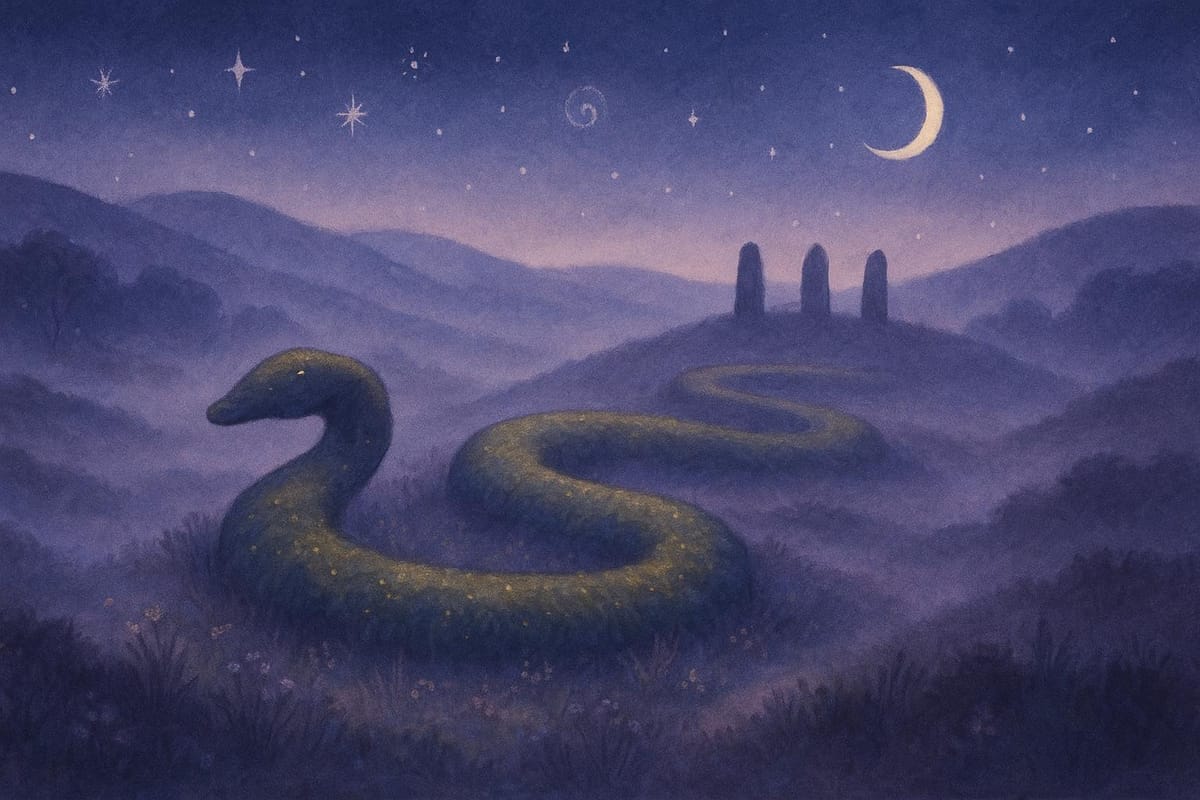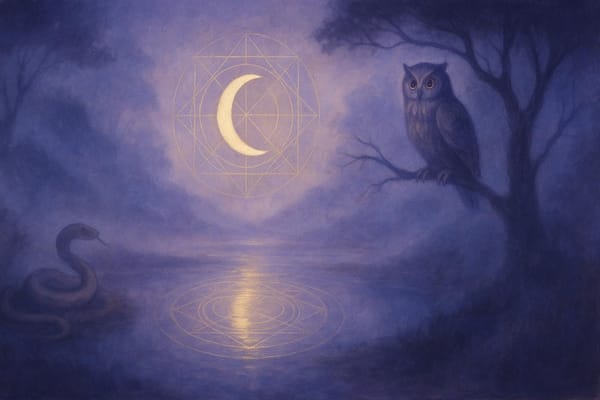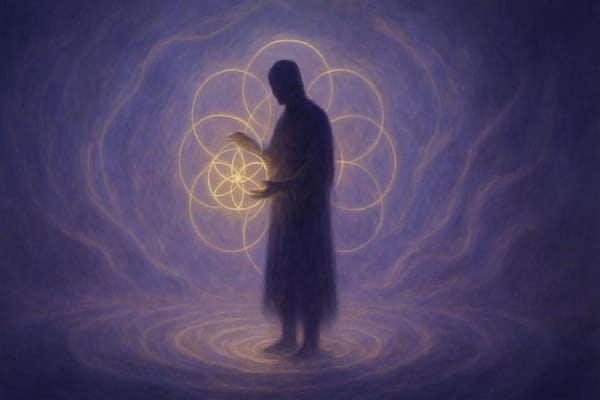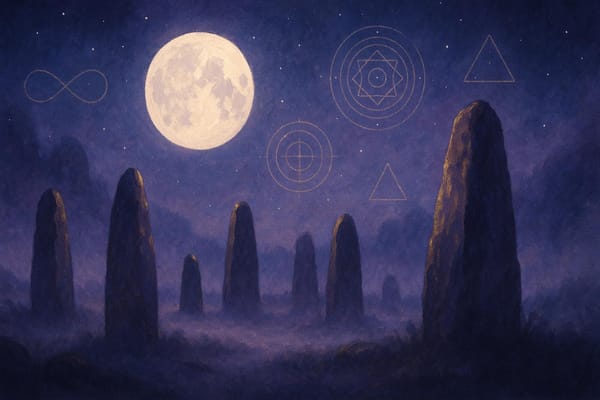Serpent Mound Scotland: The Forgotten Twin of an American Enigma
Explore the ancient serpent mounds of Ohio and Scotland, revealing their celestial alignments, cultural significance, and the need for preservation.

Did you know there are two ancient serpent mounds separated by an ocean? The Ohio Serpent Mound in the U.S. and the Loch Nell Serpent Mound in Scotland share striking similarities. Both are ancient monuments shaped like serpents, aligned with celestial events, and tied to spiritual and astronomical significance. Yet, one is preserved and celebrated, while the other is neglected and fading.
Key Takeaways:
- Ohio Serpent Mound: The world’s largest serpent effigy, 1,348 feet long, aligned with solstices and built on a meteor impact site.
- Loch Nell Serpent Mound: A 300-foot-long stone serpent in Scotland, aligned with sunsets and linked to Neolithic rituals.
- Both sites reflect ancient builders' understanding of astronomy and earth energies, yet only Ohio’s site is actively preserved.
Quick Comparison:
| Feature | Ohio Serpent Mound | Loch Nell Serpent Mound |
|---|---|---|
| Size | 1,348 feet long | 300 feet long |
| Alignment | Solstices | Sunset and seasonal events |
| Materials | Earth and clay | Stones |
| Preservation | Protected, with facilities | Neglected, no facilities |
| Purpose | Ceremonial/astronomical | Ceremonial/astronomical |
These monuments showcase shared ancient knowledge and design, but while Ohio’s site thrives, Scotland’s serpent risks being forgotten. Read on to explore their mysteries, alignments, and the urgent need for preservation.
Serpent mound, Loch Nell, Oban, Scotland
Snake Symbols in Ancient Sites
Across ancient cultures, serpents were seen as powerful symbols linking the earthly and celestial realms. This imagery frequently appears in Neolithic sites, where snake motifs served both spiritual and astronomical purposes.
The significance of serpents stems from their unique characteristics. Their ability to shed skin symbolized renewal and transformation, while their flowing, sinuous movement was associated with the continuous energy of the cosmos. Archaeological discoveries back up this connection - at Nevalı Çori in southeastern Turkey, a human-sized stone head with a carved snake, dating to the 10th–9th millennium BCE, highlights this symbolism.
Interestingly, the Serpens constellation aligns with the agricultural calendar, as shown in the table below:
| Season | Serpens Position | Agricultural Significance |
|---|---|---|
| Spring | Rising in the East | Snakes emerge from the earth, signaling the start of plowing. |
| Autumn | Setting in the West | Snakes retreat underground, marking the end of the harvest. |
This celestial connection adds another layer to the snake's symbolic role, linking natural cycles with cosmic order.
"Serpent Mound is truly a powerful sacred site... A serpent is the symbol of mystery, we don't understand it, we know almost nothing about it. When we interpret it, we mostly tell what we don't know. In that, I think, lies its power. We feel we know so much, and yet we mostly live in an unknown universe, and I think Serpent Mound is that gateway to remembering that we don't really know anything. What we know is a particle or grain of sand on a beach." - Nancy Stranahan
Ancient builders saw the snake’s shedding and form as symbols of renewal and cosmic harmony. The Serpens constellation also stands out astronomically - it is the only one among the 88 modern constellations to be divided into two separate sections.
Mircea Eliade captured this concept perfectly, stating, "the serpent symbolizes chaos, the formless and nonmanifested". This may explain why ancient cultures created serpent monuments, viewing them as bridges between the physical and spiritual worlds.
The design and alignment of these serpent monuments reveal a profound understanding of natural cycles and cosmic rhythms - an understanding that continues to fascinate researchers today.
1. Ohio Serpent Mound
The Great Serpent Mound in Peebles, Ohio, holds the title of the world's largest serpent effigy, stretching an impressive 1,348 feet. This ancient marvel sits atop a meteor impact crater that dates back roughly 300 million years, blending natural history with human ingenuity. Its design not only follows the contours of the landscape but also incorporates intricate celestial alignments.
The mound itself is divided into three sections, with heights ranging from 9 inches to over 3 feet and widths between 20 and 25 feet. At its head, the serpent's open mouth appears to encircle a 120-foot hollow oval feature, adding to its enigmatic design.
A deeper dive into the mound's celestial markers reveals its sophisticated construction:
| Alignment Point | Celestial Connection |
|---|---|
| Serpent's Head | Summer Solstice Sunset |
| Oval Structure | Eastern Direction |
| Coiled Tail | Winter Solstice Sunrise |
| Three Major Coils | Moon's peak rising points |
These alignments highlight the builders' advanced understanding of astronomy. In 1985, William F. Romain conducted a survey that identified eight distinct astronomical alignments, with the most precise pointing directly to true north. Romain remarked:
"The Serpent Mound represents the struggle between the Great Horned Serpent of the underworld and the sun, with the sun represented by the oval embankment.... As to why this mythological conflict might be important enough for the Mound Builders to go to the trouble of building the Serpent Mound, we can speculate that the serpent effigy symbolized the dark forces which would include the moon, night, winter, darkness, and death; while the oval represented the sun, daytime, summer, light, and life."
Constructed from layers of clay, ash, and a protective outer rock layer, the mound features seven coils along its length, ending in a distinctive triple-coiled tail. The shape of the mound has been compared to the constellation Draco, suggesting it may have served an astronomical purpose. Positioned on a bluff overlooking Ohio Brush Creek, the effigy dominates its surroundings with both visual and symbolic power.
The oval at the serpent's head has sparked various interpretations, including theories that it represents an egg, the sun, or even a frog's body. This intentional ambiguity adds to the site's allure and hints at a shared symbolic framework that connects celestial and ceremonial traditions across cultures.
2. Loch Nell Serpent Mound
Situated along the shores of Loch Nell in Scotland, this ancient earthwork showcases a level of design sophistication that draws comparisons to its American counterpart.
Stretching 300 feet in length and rising to heights between 17 and 20 feet, the mound's precise construction is a testament to the skill of its creators. Its defined spine and intricate design hint at a deeper purpose, blending artistry with functionality.
Victorian antiquarian Constance Frederica Gordon-Cumming described the mound's craftsmanship in striking detail:
"wonderfully perfect in anatomical outline... that the whole length of the spine was carefully constructed with regularly and symmetrically-placed stones at such an angle as to throw off rain".
Within the mound, a circular burial cairn reveals traces of ritual activity, including burnt bones, charcoal, and charred hazelnuts. These findings suggest the site held significant ceremonial importance.
What sets the mound apart is its connection to the cosmos. Much like the Ohio Serpent Mound, Loch Nell's structure aligns with celestial events, further emphasizing its ritualistic role. Key features of the mound are linked to solar events, as shown below:
| Alignment Feature | Distance | Orientation | Possible Solar Connection |
|---|---|---|---|
| Eastern Cairn | 197 ft | 267° | Equinox sunset |
| First Granite Erratic | 492 ft | 245° | Samhain sunset (Oct. 31) |
| Second Granite Erratic | 476 ft | 234° | Imbolc sunset |
| Third Granite Erratic | 459 ft | 224° | Winter solstice sunset |
The mound's placement also creates a unique visual experience. Gordon-Cumming noted:
"would naturally look eastward, directly along the whole length of the Great Reptile, and across the dark lake, to the triple peaks of Ben Cruachan. This position must have been carefully selected, as from no other point are the three peaks visible.".
This alignment with Ben Cruachan holds particular importance. Around April 15th and August 29th, the sun rises behind the mountain, reinforcing the idea that the mound functioned as a solar observatory. While some scholars suggest the curving shape might incorporate a natural esker, the precise placement of stones and the deliberate astronomical alignments leave little doubt about the human intent behind its design.
Earth Energy Patterns
Both serpent mounds - Ohio's and Loch Nell's - stand out for their fascinating geological and energetic features. The Ohio Serpent Mound, for instance, sits atop a massive meteorite impact crater spanning 8.7 miles in diameter.
This ancient crater, estimated to be less than 320 million years old, creates a distinctive geomagnetic environment, contributing to detectable electromagnetic anomalies in the area. These sites, much like astronomical observatories, seem to tap into subtle earth energy fields.
When comparing the geological traits of these two sites, several intriguing parallels emerge:
| Feature | Ohio Serpent Mound | Loch Nell Serpent Mound |
|---|---|---|
| Geological Base | Meteorite impact crater | Impact-related materials |
| Crater Diameter | 8.7 miles | Undefined |
| Key Materials | Distinct impact markers | Shocked quartz shards |
| Water Proximity | Near streams | Adjacent to loch |
| Energy Alignment | Linked to regional ley lines | Aligned with triple peaks of Ben Cruachan |
The Loch Nell site, like its Ohio counterpart, showcases a deep connection to earth energies. Research by Ken Amor in 2006 revealed evidence of an ancient impact event in the region, with shocked quartz fragments scattered along Scotland's western coastline.
These shocked quartz markers, along with other signs of impact, suggest that both serpent mounds were deliberately built on locations chosen for their energetic significance. This points to a shared ancient understanding of natural energy currents and their importance.
"Water spirits loom large in global folklore traditions"
– Alanna Moore
Another layer of mystery lies in their alignment with ley lines. The Ohio Serpent Mound is part of a broader network of North American earthworks, such as the Newark Earthworks. Meanwhile, the Loch Nell serpent mound aligns with the triple peaks of Ben Cruachan, further emphasizing its intentional placement.
These shared elements - impact-related geology, proximity to water, and precise alignments - strongly suggest that ancient builders selected these locations with an understanding of their unique energetic properties.
Site Comparison
While both the Ohio Serpent Mound and Loch Nell Serpent Mound share a connection to celestial and energetic themes, their present conditions highlight striking differences in preservation and public accessibility.
| Aspect | Ohio Serpent Mound | Loch Nell Serpent Mound |
|---|---|---|
| Size | 1,348 feet long | ~300 feet long |
| Current Condition | Well-maintained and protected | In a state of decay |
| Visitor Facilities | Museum, paved paths, accessible parking | None |
| Accessibility | Wheelchair-accessible paths to main viewpoints | Located by the road with minimal crossing obstacles |
| Preservation | National Historic Landmark; tentative UNESCO candidate | No official protection |
| Management | Ohio History Connection | Unmanaged |
These distinctions highlight not only differing approaches to conservation but also the contrasting experiences offered to visitors.
While Ohio's Serpent Mound is a model of preservation, Loch Nell faces neglect, leaving its historical and cultural significance vulnerable to time and the elements.
Ohio's Serpent Mound benefits from active management and modern facilities, including a museum, paved pathways, and accessible parking. Even as repairs to the observation tower are underway, the site remains a symbol of how ancient landmarks can be preserved while respecting their historical importance.
Loch Nell, on the other hand, tells a different story. Despite its roadside location, the site lacks any visitor amenities and has become overgrown over time. Local lore ties it to the legendary hero Diarmid, and historical accounts describe it as once reaching a height of 17 to 20 feet, crowned by a stone circle symbolizing the solar disc.
"It's the only structure we have from prehistory from Britain or in Europe, as far as we can tell, that is actually a deliberate construction that uses burnt stones... This is ... going to make us rethink whole chunks of what we thought we understood about the period." - Keith Ray, Herefordshire County archaeologist
While both mounds showcase the ingenuity of ancient engineering, their current states paint a vivid picture of contrasting priorities in conservation. Ohio's protected status contrasts sharply with Loch Nell's exposure to decay, emphasizing the importance of balanced efforts to preserve these extraordinary sites and their astronomical and cultural legacies.
Conclusion
Bringing these observations together, the serpent mounds of Ohio and Loch Nell serve as timeless reminders of ancient ingenuity and their builders' deep connection to the cosmos.
Both structures showcase extraordinary engineering, with designs that align intentionally with astronomical phenomena.
Despite being separated by an ocean, these earthworks suggest a shared ancient fascination with celestial cycles. Their orientations and symbolic designs reveal a profound understanding of the heavens, hinting at a spiritual legacy that transcended geographical divides.
"Is there not something more than mere coincidence in the resemblances between the Loch Nell and the Ohio serpent, to say nothing of the topography of their respective situations? Each has the head pointing west, and each terminates with a circular inclosure, containing an altar, from which, looking along the most prominent portion of the serpent, the rising sun may be seen. If the serpent of Scotland is the symbol of an ancient faith, surely that of Ohio is the same." - Frederic Ward Putnam
These sites are more than just physical structures - they reflect a sophisticated integration of sacred landscapes and astronomical knowledge. Whether positioned within an impact crater or aligned with significant mountain features, their locations underscore the builders' advanced understanding of both earth and sky.
However, the contrasting preservation of these sites tells two different stories. The Ohio Serpent Mound enjoys protection and public recognition, while Loch Nell's serpent faces ongoing neglect. This disparity highlights the modern challenge of safeguarding ancient wisdom. These monuments still hold valuable lessons about the remarkable achievements of our ancestors in astronomy, spirituality, and design, urging us to preserve them for future generations.
FAQs
How do preservation efforts differ between the Ohio Serpent Mound and Scotland's Loch Nell Serpent Mound?
Preserving the Ohio Serpent Mound has been a well-coordinated and well-supported effort. Since 2021, the site has been under the care of the Ohio History Connection, benefiting from restoration initiatives that date back to the late 1800s.
Its designation as a state memorial provides it with protection against environmental harm and human activity, while also serving as a platform to educate the public about its historical and cultural importance.
On the other hand, the Loch Nell Serpent Mound in Scotland has not received the same level of attention. While its solar alignments and archaeological significance are acknowledged, preservation efforts are largely informal and led by local initiatives.
Recent developments, like the landowner's plans to create a conservation area, are encouraging but remain in the early stages and lack the broader support and recognition that the Ohio site enjoys.
These two sites emphasize the critical need to protect ancient earthworks. However, the difference in resources and attention between them highlights the urgency of raising awareness about Scotland's lesser-known historical landmarks.
What can the celestial alignments of serpent mounds teach us about ancient cultures' understanding of astronomy?
The serpent mounds, like the one in Scotland, showcase the impressive astronomical understanding of ancient civilizations. These structures often align with significant solar and lunar events, hinting that their creators meticulously observed and tracked celestial patterns.
Take Scotland's Argyll Serpent Mound, for instance - it appears to align with solar cycles, serving not only as a ceremonial site but also as a practical tool for monitoring seasonal changes.
This blending of spirituality and astronomy underscores how closely ancient societies connected their lives to the cosmos.
Interestingly, the resemblance between serpent mounds in Scotland and those in North America raises intriguing questions about whether these cultures shared knowledge or independently developed similar ideas, shedding light on prehistoric views of the universe.
Why were serpent mounds, like the one in Scotland, built in specific locations?
Serpent mounds, like the one in Scotland, were deliberately positioned in areas with distinct geological features and what some consider unique energetic qualities.
These ancient structures often align with solar cycles, highlighting the builders' impressive knowledge of celestial patterns and their link to seasonal rituals and sun-centered practices.
Many serpent mounds are also thought to rest along ley lines - natural energy pathways that may have been significant to ancient cultures. This placement suggests these sites served a deeper purpose beyond their physical presence.
They were likely spiritual centers, intricately tied to the earth's energy and the broader cosmos. These alignments reveal a sophisticated understanding of both the physical landscape and its metaphysical aspects.




